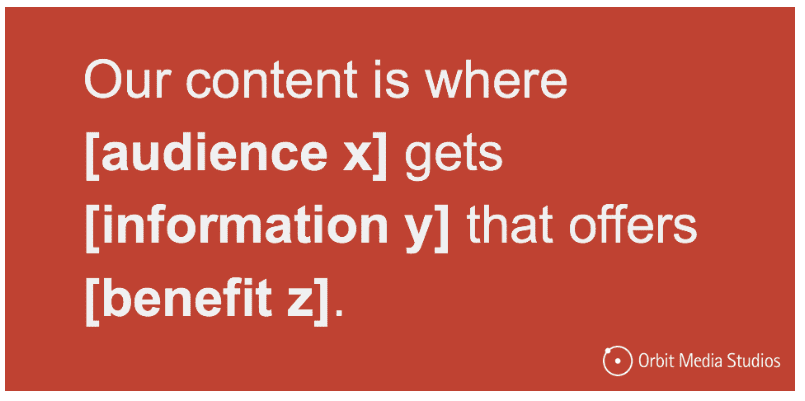YouŌĆÖve been told that you need to ŌĆśdoŌĆÖ social media and content marketing if you want to drive business. But do you know how to set better goals to ensure your success?
Google likes content, youŌĆÖve heard. ItŌĆÖs good for SEO, they said. Post more content and customers will engage with you more.
OK. So you do.┬Ā
YouŌĆÖve got your social channels, youŌĆÖve got a blog, and you sporadically create some decent posts.┬Ā

But letŌĆÖs face it, while youŌĆÖre throwing up content when you can, youŌĆÖre just too busy to spend much time planning the next bit, or the next, so it goes up in fits and startsŌĆöand doesnŌĆÖt tell a consistent story, or drive towards a clear goal.┬Ā
The OKRA Framework, which weŌĆÖll discuss in this post, is a framework for goal-setting used by teams at Google, IBM, LinkedIn, Spotify, Twitter, and other big and small companies to get teams working toward the same goals in a practical way. And you donŌĆÖt have to be a gigantic corporation to use it.┬Ā
WeŌĆÖve found that even with small teams and solopreneurs, the framework just makes sense. You start big, identifying the big thing or things you ultimately want to achieve–your Objective. Then you sort out the Key Results: this is essentially how youŌĆÖre going to track your growth and success as you move towards that bigger Objective. Finally, there are your Actions: the actual steps you need to take to accomplish those Key Results, in order to get to that Objective.┬Ā

Plus youŌĆÖre not getting any traction. Your posts generate very few likesŌĆöand the ones you do get always come from the same people (i.e., you and your close colleagues). You feel like youŌĆÖre wasting your time and energy on this whole content thing.
Sound familiar?
Before you throw in the towel, weŌĆÖve got some good news.┬Ā
You can succeed on social media, even if youŌĆÖre too busy to spend much time on it.
With a little investment of time upfront devoted to clarifying your purpose and setting some goals that are directly relevant to your business, you can increase the ROI of your social media efforts. Even if you donŌĆÖt increase your likes.┬Ā┬Ā
Our particular spin on this framework is that we go a bit bigger, right from the start. We also prompt our clients to remind themselves of their purpose, or their Why. Why? Reminding yourself of your organizationŌĆÖs big picture vision and mission, and understanding how your content fits into that, and how it expresses that–well, thatŌĆÖs always a very good thing, in our books.
With us? Good. LetŌĆÖs dig in.┬Ā
Step 1: Know Your Content ŌĆśWhyŌĆÖ (Purpose)
Finding oneŌĆÖs purpose, sure, thatŌĆÖs the task of a lifetime. But let’s not get too metaphysical today.┬Ā
WhatŌĆÖs the why of your content, on the other hand? This we can tackle.

As an agency serving purpose-driven organizations and brands, we know that purpose should serve as a guiding star: knowing your purpose as an organization means that you have a reason for doing what you do. Your purpose aligns people. It gets them on board, inspires them. Your purpose is your why even get out of bed.
Your organizationŌĆÖs purpose is often found nestled in your vision and/or mission statement, and evident in your values and your visual identity. And hopefully itŌĆÖs about more than just making a profit. After all, as Kantar ConsultingŌĆÖs Purpose 2020: Inspiring Purpose-Led Growth report finds: ŌĆ£Today, employees want to do more than sell cars. And today customers want to do more than buy cars.ŌĆØ The same report observes that compelling organizational purpose is about your positive impact on the world (and not about how your company gains).┬Ā
Knowing your positive impact in the world means you can begin to tell the right stories with your content.┬Ā
And the best way to tell the right stories is to have a clear and easy to follow ŌĆśmission statementŌĆÖ for your content. We call it your Content Purpose.┬Ā
The folks at Orbit Media recently wrote an excellent and comprehensive guide to crafting your content marketing mission statement, or content purpose statement — we heartily recommend taking a look.┬Ā
The gist is this: figure out who youŌĆÖre creating content for, what kind of content youŌĆÖre going to create, and what benefit it offers your audience.

Another way to think about it, with your organizational purpose in mind, is this:┬Ā
Who is your content for?┬Ā
Yes at some point we encourage you to develop personas to better understand, and create content for, your most important audiences. But as a starting point, consider dividing it into two groups, to create a very simple ŌĆśstarter funnelŌĆÖ for your content:┬Ā
- A larger group of people at the top of your marketing funnel: potential fans of your brand, content, services, and/or products
- Potential customers and fans: people who are likely to want your products or services and to buy from you
After all, engaging a larger audience of people who might like, share, and engage with your content is a good way to create more of that second audience.┬Ā
What kind of content are you going to offer that audience?┬Ā
HereŌĆÖs where to consider your purpose, considering your content topics, the brand stories you want to tell, channels, and content types. Most often, itŌĆÖs an intersection of what you know, and/or the stories you most want to tell, and what your audience wants and needs from you.┬Ā
What benefit are they going to receive from your content?
This is the bit that isnŌĆÖt about you or your brand at allŌĆöitŌĆÖs squarely about your audience and what they most want and need from you. You want, after all, to attract the right people to your content–and usually youŌĆÖll do that by providing content on or about topics theyŌĆÖre interested in, on the channels theyŌĆÖre likely to use, in formats that will attract and engage them. What kinds of benefits are they going to receive from coming across, engaging with, and maybe even sharing your content?┬Ā
Here are just a few possible content benefits, to illustrate:┬Ā
- ItŌĆÖs entertaining: your content is delightful, funny, or captivating
- ItŌĆÖs educational: your content teaches your audience something they need
- ItŌĆÖs beautiful or inspiring: people want and need beauty in their lives, and love content that inspires or pleases their senses
- ItŌĆÖs practical: your content might help your audience make a decision or get something done that they need done
- It provides timely information: your content might offer your audience news or an update they need to know about at the time they most need it
Got it? Great! Onto Step 2 …
Step 2: Identify Your Content Marketing Objectives
Content marketing isnŌĆÖt a panacea for all that ails your business. But it can help you to accomplish your business goals. And learning how to set better goals is a key place to begin. These are just a few of the key objectives that our clients have noted as important to them.┬Ā
Compel people to learn more about your brand
Highest-quality content with purpose should leave your audience impressed and relieved. It should help them in some way. It should make them think: wow, thatŌĆÖs incredibly useful or thatŌĆÖs something I didnŌĆÖt have straight before. Which should, ideally, drive them to action: clicking on a link to your site to learn more about the brand behind the awesome content, for example; signing up to your newsletter; or maybe reaching out to talk. And even if they donŌĆÖt take action now, you want to leave them with clarity about whoŌĆÖs behind the content, so that theyŌĆÖll think of you when they need your product or service.┬Ā
Help your audienceŌĆöand get them to trust you┬Ā
When you produce good content that serves a purpose for your audience (as well as your brand) youŌĆÖre getting somewhere good. Your audience likes your content. TheyŌĆÖre grateful for it. They want it. And they grow to like and trust your brand–making them far more likely to opt in to hear more from you–and maybe to buy, too.┬Ā
Educate your audienceŌĆöand shine as a thought leader or expert
Brands that have something to teach, show or share with their customers are in a perfect position to take advantage of content marketing as it sets you up out of the gate to create helpful, useful content for people who want and need it. Answer your customerŌĆÖs questions with videos and blog/social posts. Show them how to do or make something with your product. Share a how-to from one of your clients.┬Ā
Educate and informŌĆöto make life easier for your sales team
It used to be that sales reps or staff provided information on a product or service, and why you should buy it. So much of this can be accomplished now through great content: informational videos, highlighted user testimonials, website copy, social content ŌĆö you name it. The goal of most marketing is to ultimately prompt purchase, and content can most certainly help, starting by informing your potential customers so that they can self-select: are you right for them? They decide how far to go, and when to take actionŌĆösooner, and more assuredly, of course, based on your content.┬Ā
Engage your audienceŌĆöand ensure that more people get to know and like you┬Ā
Conversation is a timeless artŌĆöand itŌĆÖs what social media is all about. Create content that strikes up a conversation: ask questions in your content, answer comments, answer audience questions. Conversation is connection. Make yours authentic, human, and generous. The bonus of engaging your audience? Platforms like Facebook and Instagram reward accounts with high engagement by making them more visible in othersŌĆÖ feeds. So high engagement often means more reach, and more people getting to know you.┬Ā
Tell people about your culture and ŌĆśemployer brandŌĆÖŌĆöto better recruit them┬Ā
Recruiting is sometimes a top priority of our clients, but it can be a side benefit of content marketing as well. You are, after all, showcasing who you are and what youŌĆÖre about with your contentŌĆöthis helps prospective employees get an inside peek at what it might be like to join your team. Telling your founding stories, values stories, and team stories can be an excellent way to showcase your ŌĆśemployer brandŌĆÖ: who you are to the people who work with you, as well as to your customers.┬Ā
Attract more attentionŌĆöto bring audiences into your fold
We love and use the Hubspot Flywheel model in our business, which adds curves to the olŌĆÖ funnel model–moving away from a linear path (which few customers follow) towards a ŌĆśhop on and offŌĆÖ flywheel. The model posits that content is an essential element to help attract, engage, and delight an audience — at multiple points in their journey — which may include prospects as well as loyal followers at any of the given stages.┬Ā
Set Your Objectives: The TL;DR Version
Of course your objectives will be unique to your organization. But in our experience, the things that content marketing can help most with boil down to these five categories.┬ĀSet better goals by starting here.

REACH
If youŌĆÖre looking to grow brand awareness among new buyers at the ŌĆśtop of the funnelŌĆÖ, this goalŌĆÖs for you.
ENGAGEMENT
Are you looking to create a deeper relationship with your audience or customers? To build trust? Or to change their perception of your brand? Step right up.
CONVERSION
This goal category is squarely focused on sales, and working your way toward more of them.
RETENTION
This goal category is focused on keeping the ones youŌĆÖve got: encouraging existing customers to stay with you, to buy more, and to love what youŌĆÖre about.
ADVOCACY
Going slightly beyond retention, advocacy is about delighting your audience and getting them to love what you do enough to spread the good word about your brandŌĆ”helping to accomplish your ŌĆśReachŌĆÖ Objective and begin the cycle all over again.
Step 3: Identify the Key Results You Want to Achieve┬Ā
We could all use a little more reach, engagement, conversion,┬Ā retention and advocacy. Right? But trying to do it all is kind of like trying to ŌĆ£winŌĆØ at life. Spreading yourself too thin leads nowhere good. So we invite you to ask yourself this, when learning how to set better goals: what results are most important to you? What content results are going to help you meet your business goals while also helping you to express your purpose?┬Ā
The answer to this might be obvious to you. But if you arenŌĆÖt sure, take a look at some of the ŌĆ£Key ResultsŌĆØ that are important to some of the purpose-driven clients weŌĆÖve worked with.┬Ā
KEY RESULTS FOR REACH
When business leaders are looking to accomplish more reach, theyŌĆÖre often looking to attracting more people at an early stage, and to accomplish more brand awareness at the ŌĆśtop of the funnelŌĆÖ (sometimes called TOFU).┬Ā
When measuring your success in achieving reach, these are some of the most common metrics we see being used:┬Ā
- Overall traffic, including spikes and dips in page views
- Visits
- New visitors
- Percentage of new visitors
- Entry pages┬Ā
- Visitor geography┬Ā
- Impressions
- Keywords┬Ā
ENGAGEMENT
If youŌĆÖre looking for more engagement with your content, youŌĆÖre often looking at how to keep people interested and spending time and attention with you on your site and socials.
To gauge this, many brands use tools like Google Analytics, email software (we use Mailchimp) and either native social media tools, or tools that you use to schedule your socials (we use SproutSocial, HeyOrca, Hootsuite, Buffer) to measure metrics such as:┬Ā
- Bounce rate
- Time on site
- Repeat visits
- Newsletter subscribers┬Ā
- Email open rate
- Email CTR
- Average social shares
- Social engagement rates
CONVERSION
Achieving more conversion is usually about getting your audience to take action. Are you, for example, getting the kinds of inquiries you need that will eventually lead to sale?┬Ā
To know, many brands take a look at metrics like these:┬Ā
- Inquiries (calls, contact form completions, emails)
- Email subscriptions
- Event/webinar signups
- Downloads of lead magnets
- Leads
- Qualified leads (via your CRM)┬Ā
- Leads from specific sources
- Actual sales┬Ā
- Add to cart rate
- Conversion rate (ecommerce)
RETENTION
Aiming for retention is usually about keeping (and keeping happy) the customers you have. This oneŌĆÖs tricky to measure with traditional tools, but you can get a sense through your CRM and any sales tracking tools you use, measuring things like:┬Ā
- Retention rate
- Customer lifetime value
- Cost to acquire customers
- Net promoter score (NPS)┬Ā
ADVOCACY
When aiming for advocacy, youŌĆÖre keen to see that your customers or employees are sharing great things about your brand, its products or services. There are myriad ways to share the love, and while traditional word of mouth is one of the most powerful, consider tracking these metrics as well:
- Content shared through social media┬Ā
- Engagement rate by customers or employees┬Ā
- Total number of advocates
Check out this helpful guide for a much deeper dive into setting specific KPIs for your content marketing initiatives.┬Ā
Step 4: Take Action┬Ā
Once you’ve sorted out how to set better goals for your content, the actions you take to achieve your Key Results (which should in turn help you achieve those bigger Objectives, and express your Purpose) will be utterly unique to you.┬Ā
In general we recommend attaching 1-5 prioritized actions or steps to each of your Key Results. For us, these are strategic actions and must be thoroughly considered in light of your budget, your resources and team, your abilities, and your time.┬Ā
Summary┬Ā
Sorting out your content marketing isnŌĆÖt always easy, but taking the time to identify what you most want to accomplish for your business, and how your content can most efficiently and effectively help you accomplish that is an invaluable investment.┬Ā
Good luck in your journey and let us know how we can help!┬Ā┬Ā













